The conductorettes: the first women to drive transit in Vancouver
The conductorettes: the first women to drive transit in Vancouver
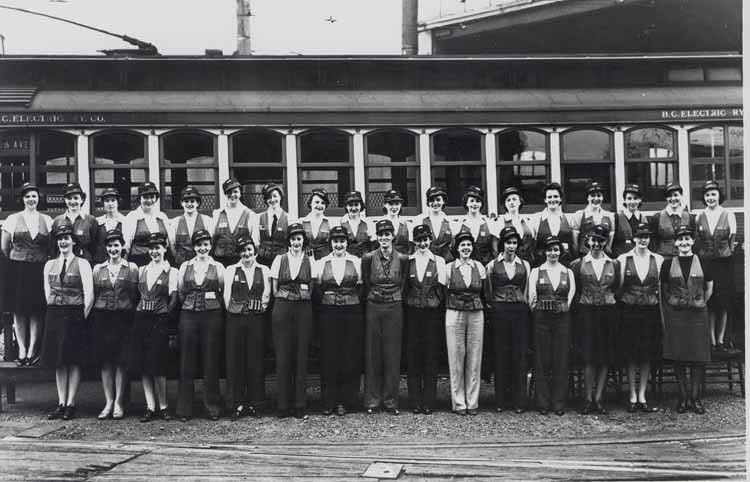
Today, I’m pleased to present the story of the conductorettes, a group of 180 women who were the only women operating transit vehicles between 1943 and 1975.
And I’m especially pleased to tell you that this article includes an audio podcast containing interview excerpts from three former conductorettes.
Again, Lisa Codd, the curator at the Burnaby Village Museum, helped me put this article together, based on the research of Lynda Maeve Orr, the Museum’s Assistant Programmer. It’s a continued collaboration to explore transit history and Burnaby’s archival holdings!
Podcast with three former conductorettes: Pearl Wattum, Vilma Westerholm, Edra McLeod
The article continues below, but here you can hear the podcast containing interview excerpts from three former conductorettes: Pearl Wattum, Vilma Westerholm, and Edra McLeod.
To listen to the podcast, press play on the player above, or download the mp3 here. You can also subscribe to our podcast via RSS.
The taped interviews with the conductorettes were conducted by the Vancouver Historical Society in 1981 as part of an oral history project, and can be found at the Special Collections at the University of British Columbia. The recordings are used with the kind permission of the Vancouver Historical Society.
The story of the conductorettes: the Second World War pulls women into transit work
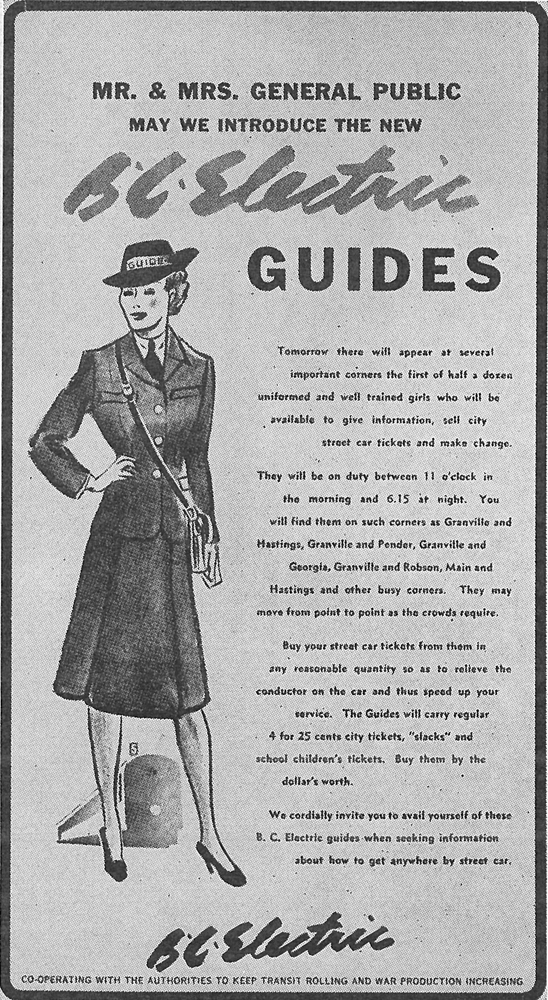
In 1943, the B.C. Electric Railway hired women to work on transit, to help address the labour shortage during the Second World War.
Besides labour shortages, the B.C. Electric Railway was dealing with an increase in demand for its services. With gas rationing taking place during the war, public transportation was more popular than ever, and the company was pressed to stretch existing resources to the limit.
(For example, the B.C. Electric Employees Magazine reported that the average number of passengers per day increased from 150,000 in January 1938 to over 270,000 by March 1943!)
The women hired during this time were called “conductorettes.” They worked on the streetcars, and only on the Vancouver routes—you wouldn’t find them on the interurbans.
The company also hired women to work as “Electric Guides,” selling pre-sold tickets at busy streetcar stops in Vancouver.
As you may remember from social studies class, this was not a particularly unusual situation: women were hired into non-traditional work during the war years because of the labour shortage, which opened the door for women to work.
Other Canadian and American cities also hired women to work on their streetcar systems as conductors.
Who the company was looking for
The company’s Vancouver Sun advertisement in June 1944 called for the following:
Women aged 25 to 35 to work as streetcar “Conductorettes.” Applicants will be considered on the basis of good appearance and general intelligence.
The B.C. Electric Railway, however, preferred to hire married women between the ages of 25 and 35 – so said the company’s transportation manager, when interviewed by the Vancouver Daily Province in August 1943.
Furthermore, the BC Electric Employees Magazine emphasized that the women couldn’t be married to just anyone — it was preferable to hire wives of men who serving overseas.
The magazine stressed the women would be held to the same requirements as men: their health, vision, sight, and IQ must be up to standard.
Winnifred Trounce was one of these new conductorettes. Interviewed in the employee magazine in October 1943, she explained that her husband was serving overseas, and she was both selling tickets for the BCER and looking after her two young children.
She didn’t expect to be working for long, however. “It’s one thing to help fill the gaps when the men are fighting, but when they return my place will be home with my children,” she said.
However, the taped interviews done with three of the women themselves do paint a different picture from the one expected by the company.
Generally, they didn’t indicate that their motives were patriotism: they just jumped at the opportunity for a good paying job. The women had worked outside of the home before the war, often in jobs that offered little pay or security.
The conductorettes’ work
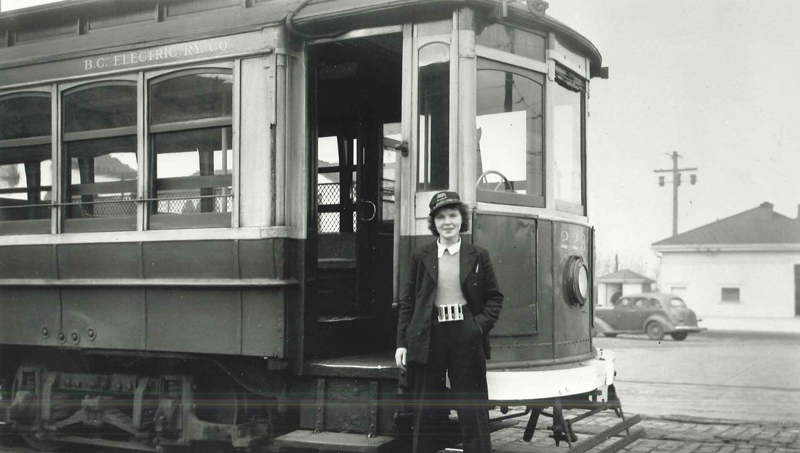
The conductorettes did the same work as conductors: taking fares, collecting tickets, calling out stops, and working with the motorman who drove the streetcars.
One of the conductorette’s duties was also moving the trolley pole if required, which sometimes involved scrambling up the side of the trolley if something was out of sorts.
But as the conductorettes were first issued skirts in their uniforms, climbing the trolley could be a real challenge. Eventually, the conductorettes were issued pants as part of their uniform instead.
As conductorette Pearl Wattum explained, “It’s no goddamn place for a woman up the side of a trolley in a skirt.”
(Pearl is one of the women can be heard on tape at UBC Special Collections, and was described by another conductorette as having a “rough mouth and a warm heart.”)
Conductorettes also generally attended to the passengers, handling any issues that would arise on the streetcar.
From time to time there would be drunks on the car, and all the conductorettes interviewed talked about handling them.
Pearl recalled a drunk woman telling her she should be home with her children — she responded by saying, “Well, you’re no Valentine yourself.”
She also recalled a drunk boarding the streetcar and then giving her “all the four letter words in the deck.”
In response, Pearl wound up punching him in the face, knocking him clean out.
“You’da popped him too,” she said. “I’m a big girl, and I had muscles in those days. When he was popped, he was popped.”
Perceptions
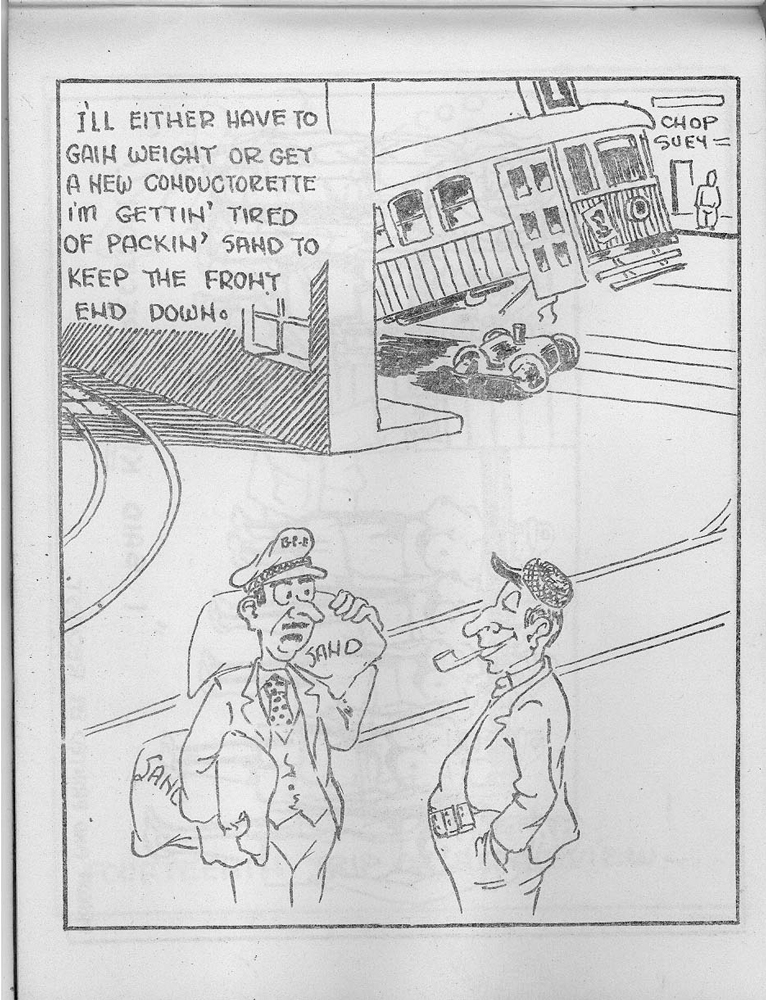
In their interviews, the women report that people enjoyed them being there. During the war effort, people were accustomed to seeing women in unorthodox fields, due to the shortage of men.
“All the girl drivers they were really super girl drivers, they really were,” said Vilma Westerholm, another of the former conductorettes interviewed in 1981. “And the general public liked them very much.”
But while the women reported few problems working with the men at B.C. Electric, other artifacts from the time indicate that wasn’t always the case.
This comic is just one mild example showing how the men made fun of the conductorettes. It was part of a joke booklet called Slack Brakes, drawn and distributed among the workers (and definitely not an official company publication).
Far more explicit cartoons were in the book too, making lewd reference to their sexuality.
As Lisa Codd, the curator at the Museum, describes:
“The cartoons clearly show a prejudice that women (especially attractive women!) are disruptive in the workplace. While we can see the cartoons as “all in good fun” they do clearly illustrate that the women were viewed differently than men who performed the work. The women interviewed don’t report much problem with sexism among passengers or workers, but the cartoons suggest they still weren’t viewed as just ‘one of the guys.’”
What happened after the war?
Unusually, the conductorettes were not let go after the Second World War came to an end. And they actually kept their jobs because they had full membership in the union.
“They thought they would try and get us off after the war,” said Vilma Westerholm in her interview. “But the union said ‘No, they stuck when you needed them, so why shouldn’t they keep their jobs? The general public likes them.’ So we stayed.”
From the start, the union had insisted on the women having full membership from the start, with the same rights, responsibilities, and pay as men.
Making them full union members was intended to keep wages high and preserve men’s jobs after the war.
When women first began working on the streetcars, the union was concerned this would bring their wages down—which typically happened when women entered male fields.
They also worried that the presence of lower-paid women would threaten the jobs of men returning from overseas. The company would just hire more women at lower cost after the war.
And when the war came to an end, as Vilma says, the union supported the women conductors when they fought to have their seniority recognized by the company.
With a shortage of men after the war, B.C. Electric kept the women on, though many did choose to leave when their husbands returned.
The women, however, were grandfathered into the organization—no new women would be hired, but the women already employed could continue.
Vilma was one of the women who stayed on, and here’s what she said about that.
“There were a lot of girls on during the war, but when their husbands came back a lot of them stopped. They didn’t want to go on the buses. Well, some of them, I don’t know, they didn’t seem to care about driving buses. Being by themselves.
But I was waiting for that, because I loved driving. I thought gee that’s just great. Because you’re more controlled, you have control of it, you don’t have to worry about what the motorman’s going to say. You’re on your own and as long as you did your work, no one bothered you.”
Rails to rubber
The next challenge came when the company went to one-man streetcar operation – with a motorman who did the job of both the conductors and the motormen – driving the car and collecting the fares.
In the 1950s, the company combined the seniority lists, allowing conductors to become motormen and be called out on shifts according to seniority. Women were given the option of learning to drive or being let go.
Edra McLeod, one of the women interviewed about her work as a conductorette in 1981, describes that Pearl Wattum, their shop steward, told them all to get out there and drive.
Thirty women did learn to drive the streetcars, but the women had to prove themselves again when the streetcars were phased out and replaced with buses. Licensing was provided in Victoria, and Victoria had to give special approval to allow women to drive buses.
By the 1970s, there were only two women left driving buses in Vancouver: Edra McLeod and Vilma Westerholm.
Then in 1975, the company, now part of B.C. Hydro, finally began hiring women. The former conductorettes were even used as an example of women who worked.
Vilma remembered it well. “During the last year I was there, or the year before last, the new girl came on, and she trained with me, and she was the first one of the new bunch,” she said.
Vilma spent 32 years and 3 months working for transit before she retired in 1976. Edra retired the next year, after 31 years and 9 months on the job.
Reflections
Looking back, it’s easy to see that the conductorettes’ work blazed a trail for women working after them. By capably taking on this work, the women proved they could do just as much as men.
Yet the conductorettes didn’t necessarily feel they were trailblazers. The three interviewed said they took the jobs for the pay—none had thought directly about the later implications of their work for women at large.
For example, when asked why she stayed on for 28 years, Pearl Wattum replied that, “I liked it. And the money was good. I had to pay the rent. As I say I wasn’t married in those days, and it was an income.”
Just Edra McLeod seemed to recognize, with some hesitation, that her work had made a difference to people.
“[My granddaughter]came out the last day for a ride in the summer,” Edra said in her interview. “And she said that her grandmother is a living legend, someone told her this.” She then let out a laugh.
Where are they now?
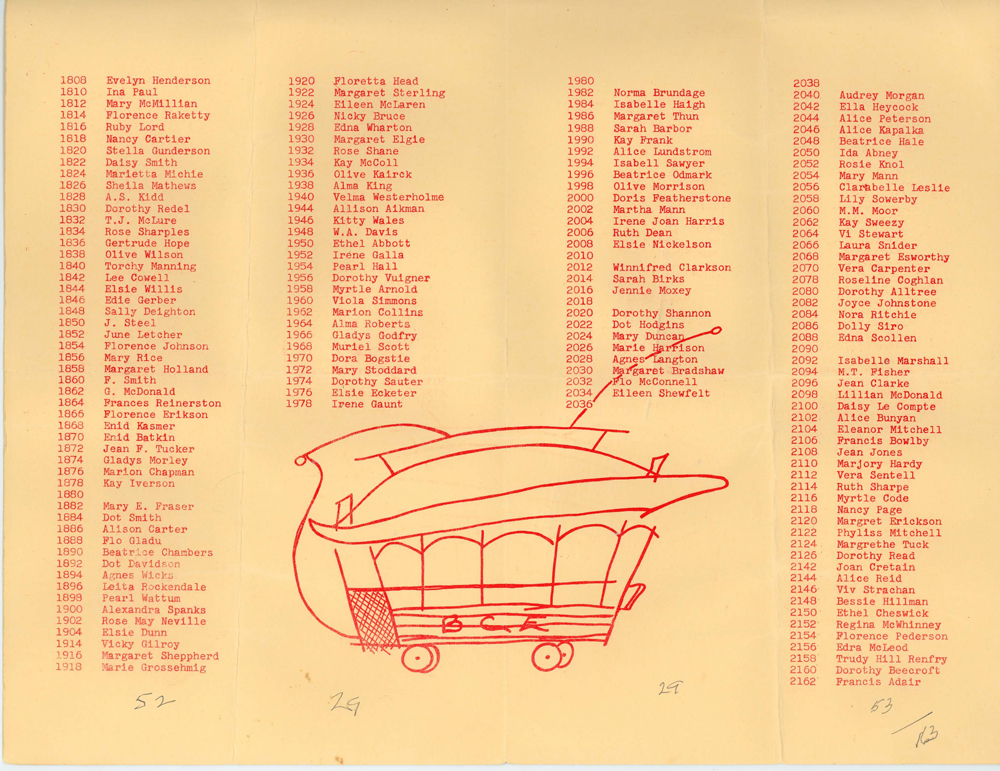
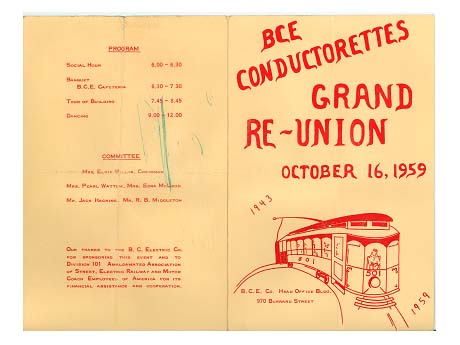
To be quite honest, we don’t know where a lot of the conductorettes ended up.
Lisa has provided the program from their 1959 reunion, which features a list of all of their names – please do have a look and let us know if you know any of them.
Lisa has showcased the conductorettes’ story in exhibits before, and would love to get in touch! She can be contacted at lisa.codd@burnaby.ca
Want more history?
Thank you again to curator Lisa Codd for all her help with this article! Check out our earlier collaborations, exploring the history of the interurbans, in the Transit History category.
Many thanks to the B.C. Hydro Corporate Library for letting us share their image on the blog.
As well, the audio excerpts are provided thanks to the great kindness of the Vancouver Historical Society, and the research help of UBC Libraries’ Rare Books and Special Collections branch. If you’d like to look up the interviews yourself, please do search the UBC library records for the terms “Pearl Berrington,” “Edra McLeod” and “Vilma Westerholm”.
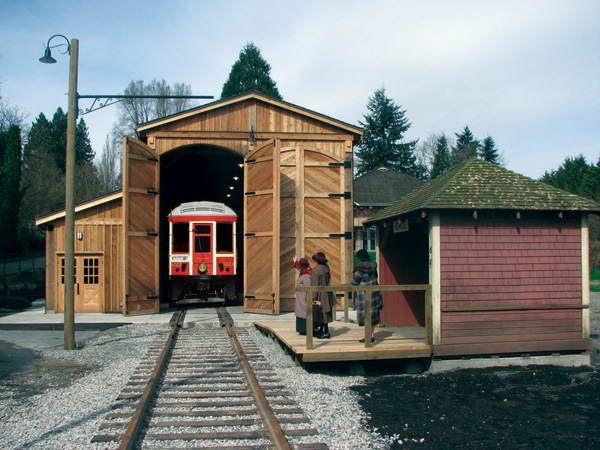
And of course, visit the Burnaby Village Museum for more history treats! Again, it’s is an open-air museum that recreates life in 1920s Burnaby. It’s open during the summer, and presents a Haunted Village from 6 p.m. to 9 p.m. during October 28 to 30 for Halloween. (Check the museum’s website for admission costs and more!)
For more on local transit history, take a look at the books of Henry Ewert – he’s a local historian who has written books such as The Story of the B.C. Electric Railway, Vancouver’s Glory Years: Public Transit, 1890-1915, Victoria’s Streetcar Era, and The Perfect Little Street Car System: From Ferry to Mountain in North Vancouver, 1906-1947.
You can also try TRAMS, the Transit Museum Society, who run a real-life restored streetcar on the Downtown Historic Railway. And B.C. Hydro’s Power Pioneers association runs a great history website that includes info on streetcars.
And you can’t beat Chuck Davis for more regional history – check out his website, and his terrific series in Regarding Place magazine called A Year in Five Minutes, which showcases stories from each year in Lower Mainland history.
Hope you enjoyed this look back at transit history!






[…] The Buzzer blog » The conductorettes: the first women to drive transit in Vancouver buzzer.translink.ca/index.php/2009/11/the-conductorettes-the-first-women-to-drive-transit-in-vancouver – view page – cached A group of 33 conductorettes posing in front of the 16th Avenue streetcar at Prior Street barns. They were at first issued skirts as part of their uniform, but this image shows the transition to… Read moreA group of 33 conductorettes posing in front of the 16th Avenue streetcar at Prior Street barns. They were at first issued skirts as part of their uniform, but this image shows the transition to pants. Skirts were difficult to manage when climbing the trolley to reset the poles! Photo courtesy of the Coast Mountain Bus Company Archives. Read less […]
I’d like to see a transit goon today mouth off to Pearl Wattum. If I had it my way, she’d be in charge of transit security!
If the women had to wear skirts… why couldn’t the men wear kilts???
Jhenifer:
Thanks very much for these historical articles, not to mention all the tidbits from old Buzzers that you consistently dig up. Please keep them coming!
The Buzzer was already a unique publication when it was just in its paper form, but with this blog, you’ve really turned it into a first-class enterprise.
[…] The conductorettes: the first women to drive transit in Vancouver […]
[…] Day, celebrating the many achievements of women, I thought I’d point you over to this 2009 Buzzer post about the conductorettes: the first women to drive transit in the Lower […]
[…] Anna Dean, who retired from TransLink last year, shares her story of being a woman in the transit industry with the Vancouver Sun (the article mistakenly says BC Transit!) Incidentally, Edra McLeod, who is mentioned in the story, is part of the podcast in my 2009 post about the conductorettes. […]
Really enjoyed the story of the Conductorettes and, of course, the other articles as well.
Just one wee thing, if I may … BC Hydro started hiring female bus drivers again earlier than 1975 … in fact, I started at Oakridge in September 1974.
Thanks again,
Marilyne
Marilyne: Thanks for the clarification! And many thanks for being a pioneering woman driving transit :)